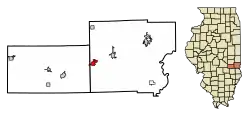Casey, Illinois
Casey (pronounced CAY-z) is a city in Clark and Cumberland counties in the U.S. state of Illinois. The population was 2,762 at the 2010 census and as of 2018, the population had decreased to an estimated 2,635.[4]
Casey | |
|---|---|
 Casey city hall | |
| Nickname(s): a Small Town with a Big Heart[1] | |
 Location of Casey in Clark County, Illinois. | |
.svg.png.webp) Location of Illinois in the United States | |
| Coordinates: 39°17′58″N 87°59′24″W | |
| Country | United States |
| State | Illinois |
| Counties | Clark, Cumberland |
| Townships | Casey, Union |
| Area | |
| • Total | 2.15 sq mi (5.57 km2) |
| • Land | 2.15 sq mi (5.57 km2) |
| • Water | 0.00 sq mi (0.00 km2) |
| Population (2010) | |
| • Total | 2,769 |
| • Estimate (2019)[3] | 2,620 |
| • Density | 1,218.04/sq mi (470.26/km2) |
| Time zone | UTC-6 (CST) |
| • Summer (DST) | UTC-5 (CDT) |
| ZIP code | 62420 |
| Area code(s) | 217 Exchange: 932 |
| FIPS code | 17-11618 |
| Wikimedia Commons | Casey, Illinois |
| Website | http://www.cityofcaseyil.org/ |
The Cumberland County portion of Casey is part of the Charleston–Mattoon Micropolitan Statistical Area.
Casey is the home to several Guinness World Record constructions - super-sized items in the form of outdoor sculptures—including the Wind Chime, Rocking Chair, Knitting Needles, Crochet Hook, Pitchfork, Golf Tee, Yardstick, Wooden Token, Dutch Wooden Shoes, Mailbox, Pencil and Birdcage.
Geography
Casey is located at 39°17′58″N 87°59′24″W (39.299543, -87.990056).[5] Most of the city lies in Clark County, although a small portion extends into Cumberland County. In the 2000 census, 2,940 of Casey's 3067 residents (99.9%) lived in Clark County and 2 (0.1%) lived in Cumberland County.[6]
According to the 2010 census, Casey has a total area of 2.16 square miles (5.59 km2), all land.[7]
Demographics
| Historical population | |||
|---|---|---|---|
| Census | Pop. | %± | |
| 1880 | 778 | — | |
| 1890 | 844 | 8.5% | |
| 1900 | 1,500 | 77.7% | |
| 1910 | 2,157 | 43.8% | |
| 1920 | 2,189 | 1.5% | |
| 1930 | 2,200 | 0.5% | |
| 1940 | 2,543 | 15.6% | |
| 1950 | 2,734 | 7.5% | |
| 1960 | 2,890 | 5.7% | |
| 1970 | 2,994 | 3.6% | |
| 1980 | 3,026 | 1.1% | |
| 1990 | 2,914 | −3.7% | |
| 2000 | 2,942 | 1.0% | |
| 2010 | 2,769 | −5.9% | |
| 2019 (est.) | 2,620 | [3] | −5.4% |
| U.S. Decennial Census[8] | |||
As of the census[9] of 2000, there were 2,942 people in 1,266 households, including 758 families, in the city. The population density was 1,385.0 people per square mile (535.8/km2). There were 1,454 housing units at an average density of 684.5 per square mile (264.8/km2) 87.The racial makup of the city was 98.67% White, 0.4% African American, 0.14% Native American, 0.03% from other races, and 0.71% from two or more races. Hispanic or Latino of any race were 0.24% of the population.
Of the 1,266 households 28.2% had children under the age of 18 living with them, 44.4% were married couples living together, 12.2% had a female householder with no husband present, and 40.1% were non-families. 36.7% of households were one person and 20.2% were one person aged 65 or older. The average household size was 2.22 and the average family size was 2.90.
The age distribution was 24.1% under the age of 18, 7.9% from 18 to 24, 24.1% from 25 to 44, 20.7% from 45 to 64, and 23.2% 65 or older. The median age was 40 years. For every 100 females, there were 80.3 males. For every 100 females age 18 and over, there were 74.5 males.
The median household income was $30,089 and the median family income was $36,941. Males had a median income of $30,809 versus $16,496 for females. The per capita income for the city was $16,266. About 11.5% of families and 15.4% of the population were below the poverty line, including 20.6% of those under age 18 and 10.1% of those age 65 or over.
Records
Casey became famous because it owns eight Guinness records, including giants such as largest windchime, golf ball bars, knitting needles, giant stone chairs, old telephone poles, old chair-plates- giant mailboxes, wooden clogs, rulers and giant bird cages, ...[10][11] constructed by businessman Jim Bolin.
Notable people
- David Hanners, 1989 Pulitzer Prize winner[12]
See also
References
- http://cityofcaseyil.org/
- "2019 U.S. Gazetteer Files". United States Census Bureau. Retrieved July 14, 2020.
- "Population and Housing Unit Estimates". United States Census Bureau. May 24, 2020. Retrieved May 27, 2020.
- Bureau, U. S. Census. "U.S. Census website". United States Census Bureau. Retrieved 2020-03-31.
- "US Gazetteer files: 2010, 2000, and 1990". United States Census Bureau. 2011-02-12. Retrieved 2011-04-23.
- "Subcounty population estimates 2000-2006: Illinois". United States Census Bureau, Population Division. 2007-06-28. Archived from the original (CSV) on 2008-10-08. Retrieved 2008-06-08.
- "G001 - Geographic Identifiers - 2010 Census Summary File 1". United States Census Bureau. Archived from the original on 2020-02-13. Retrieved 2015-12-25.
- "Census of Population and Housing". Census.gov. Retrieved June 4, 2015.
- "U.S. Census website". United States Census Bureau. Retrieved 2008-01-31.
- "World's Largest Wind Chime". City of Casey, Illinois. Bolin Enterprises, Inc. Retrieved 13 November 2012.
- Reid, Tony (10 September 2012). "Casey uses world's largest wind chimes to lure visitors, businesses". Decatur Herald-Review. Retrieved 13 November 2012.
- Bennett, Mark (10 October 2007). "Wabash Valley native, Pulitzer Prize winner writes song on Fontanet powder mill explosion". TribStar. Archived from the original on 4 March 2016. Retrieved 26 May 2012.